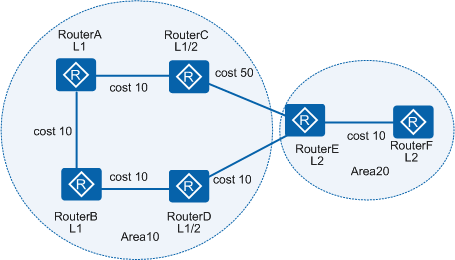IS-IS Route Leaking
Normally, Level-1 routers manage routes in Level-1 areas. All Level-2 and Level-1-2 routers form a contiguous backbone area. Level-1 areas can only connect to the backbone area and cannot connect to each other.
A Level-1-2 router encapsulates learned Level-1 routing information into a Level-2 LSP and floods the Level-2 LSP to other Level-2 and Level-1-2 routers. Then Level-1-2 and Level-2 routers know routing information about the entire IS-IS routing domain. To reduce the size of routing tables, a Level-1-2 router, by default, does not advertise the learned routing information of other Level-1 areas and the backbone area to its Level-1 area. In this case, Level-1 routers do not know routing information outside the local area. As a result, Level-1 routers cannot select the optimal route to a destination outside the local area.
IS-IS route leaking can solve this problem. You can configure access control lists (ACLs) and routing policies and mark routes with tags on Level-1-2 routers to select eligible routes. Then a Level-1-2 router can advertise routing information of other Level-1 areas and backbone area to its Level-1 area.
In Figure 1, RouterA sends a packet to RouterF. The selected optimal route should be RouterA->RouterB->RouterD->RouterE->RouterF. This is because the cost of this route is 40, which is smaller than the cost (70) of the other route (RouterA->RouterC->RouterE->RouterF). However, when you check the route on RouterA to view the path of the packets sent to RouterF, the selected route is RouterA->RouterC->RouterE->RouterF but not the optimal route from RouterA to RouterF.
RouterA (Level-1 router) does not know routes outside its area, so it sends packets outside its area through the default route generated by the nearest Level-1-2 router. Therefore, the optimal route is not used to forward the packets.
If route leaking is enabled on Level-1-2 routers (RouterC and RouterD), Level-1 routers in Area 10 can know routes outside Area 10 and passing through the two Level-1-2 routers. After route calculation, the forwarding path becomes RouterA->RouterB->RouterD->RouterE->RouterF, which is the optimal route from RouterA to RouterF.
